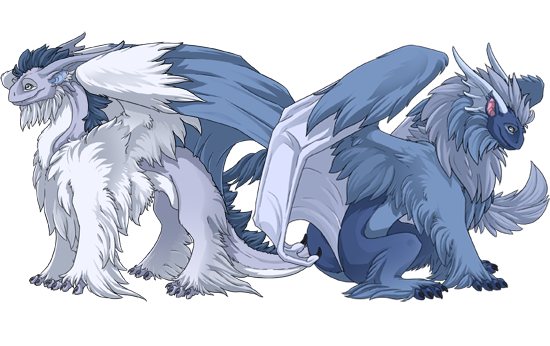
Tundra Dragons
Information about the hardy Tundra dragon species.
 |
Obtained:
Rarity:
Breeding Cooldown: Diet:
|
The Tundra species originated from the Snowsquall Tundra. Though not the the brightest of creatures, this hardy breed survives by virtue of their toughness and ability to eat almost anything that grows. Their constitution allows them uncontested domain over harsh, barren tracts of land that other dragons are pleased to avoid.
Physical Attributes
The most striking feature of the Tundra dragons is their thick, shaggy coat of fur*. As winter approaches their coats become incredibly dense and spreads to cover the entire dragon. Flight with a full winter coat is difficult and only undertaken in times of need. During the summer season Tundra dragons shed their winter coats, leaving their body covered in a much finer coat of fur, the hindquarters and lower wings exposed.
Tundra dragons who join flights in warmer climes never see their winter coats (though their summer coat is more than enough to cause heat exhaustion in locations such as the Viridian Labyrinth, Ashfall Waste, and Shifting Expanse). Tundra dragons possess impressive canine teeth used for combat. The majority of their jaw is set with flat, wide molars, perfect for grinding up scrub.
Social
Tundra dragons form deep bonds within their family groups, and are loathe to leave their birth clan. They are not a chatty species, though they enjoy the company of others. Companionable silence is welcome, as is simply listening to other dragons' tales.
Tundras have difficulty remembering names, faces, and specific details about dragons that they have not seen in over a season. Despite this, their olfactory memory is excellent. "You smell like a friendship." is a common greeting between Tundra dragons who have not seen one another in years, the names and details of their association forgotten. When encountering a dragon who smells like friendship, Tundras typically attempt to become friends again. This "friend-again" may present an awkward situation for a dragon of a different species. The Tundra treats the relationship as if they were meeting for the first time, introducing themselves and asking questions that have likely been rehashed many times before.
In the same manner, Tundra dragons remember individuals who wronged them by smell alone. "You smell like an enemy." can result in feuds between clans that span centuries, the exact reason for their squabbling long-forgotten.
Lairs
Tundras are natural burrowers. In warmer climes the burrow presents a cool refuge from hot winds and beating sun. These burrows are elaborate underground mazes, with interconnected chambers created for each mated pair or family. The chambers and passages of the burrow are shored-up with branches and trunks stripped clean of their foliage. (a delicious but difficult undertaking!)
Tundra dragons graze daily during spring, summer, and autumn. The flock travels great distances each day to find fresh feeding grounds, taking great care not to overgraze any particular stretch of land. A small number of dragons remain behind to oversee the lair and any hatchlings too young to make the journey. These individuals rotate their duty day-to-day so that all members of the clan have a chance to feed. A few unruly hatchlings in every clan use this "changing of the guard" to their advantage, making all manner of mischief against their unwitting guardians.
Tactics
Tundra dragons go to great lengths to avoid combat, shrugging off blows and readily agreeing to get out of the way; however, if a member of their clan is in true peril the flock will cluster together presenting a unified front. Breath attacks are the favored weapon of the Tundra. Flocks instinctively coordinate their breath attacks in perfectly timed waves, leaving few gaps of time in which the air is not filled with a wall of their element.
* The summer coat is pictured at the top of the article and is the coat used as the official breed artwork.

